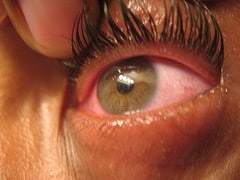A transparent cornea is essential for vision, which is why the eye has evolved to nourish the cornea without blood vessels. But for millions of people around the world, diseases of the eye or trauma spur the growth of blood vessels and can cause blindness.
A new Northwestern Medicine study has identified a gene that plays a major role in maintaining clarity of the cornea in humans and mice — and could possibly be used as gene therapy to treat diseases that cause blindness. The paper is published in the Proceedings of the National Academy of Sciences.
“We believe we’ve discovered the master regulator gene that prevents the formation of blood vessels in the eye and protects the clarity of the cornea,” said lead author Tsutomu Kume, associate professor of medicine at Northwestern University Feinberg School of Medicine and a researcher at Feinberg Cardiovascular Research Institute.
The existence of the gene, FoxC1, was previously known, but its role in maintaining a clear cornea is a new finding. Working with a special breed of mice that are missing this gene, Kume and colleagues found abnormal vascular formations, or blood vessels, streaking their corneas and blocking light.
When Kume discovered the corneal blood vessels in the mutant mice, he called a collaborator at the University of Alberta in Canada, Ordan Lehmann, MD, professor of ophthalmology and medical genetics.
Lehmann found that his patients who have a single copy of this mutated FoxC1 gene — and who have congenital glaucoma — also have abnormal blood vessel growth in their eyes.
“The exciting thing is by showing the loss of FoxC1 causes vascularization of the cornea, it means increasing levels of the gene might help prevent the abnormal growth of blood vessels, potentially in multiple eye disorders that cause blindness,” said Lehmann, a coauthor on the paper. “That’s the hope.” One possible use might be in corneal transplants, he said, where the growth of new blood vessels onto the transplanted cornea is a major problem.
Kume next plans to test the gene therapy in mice to see if injecting FoxC1 inhibits the formation of blood vessels in the cornea.


